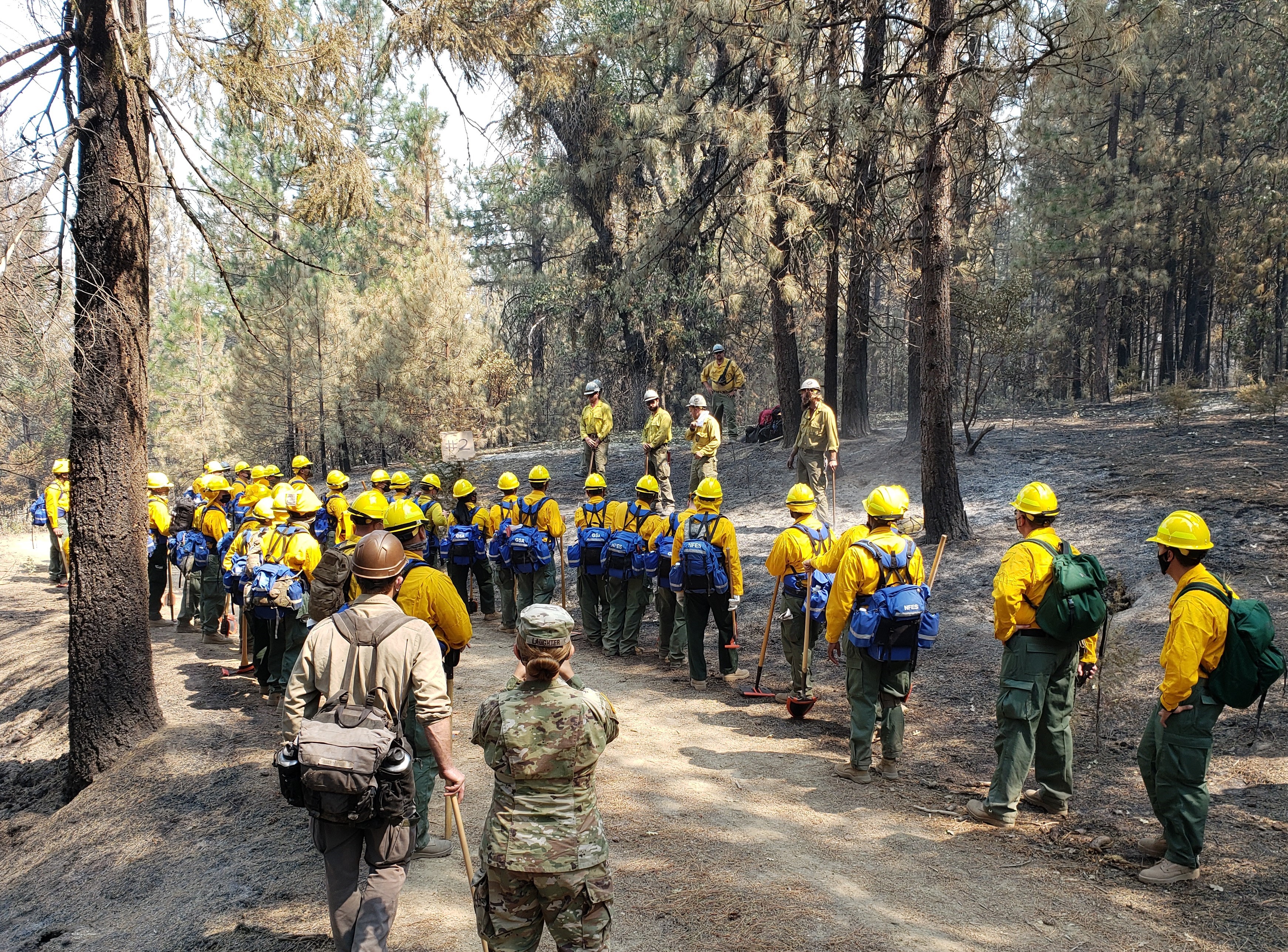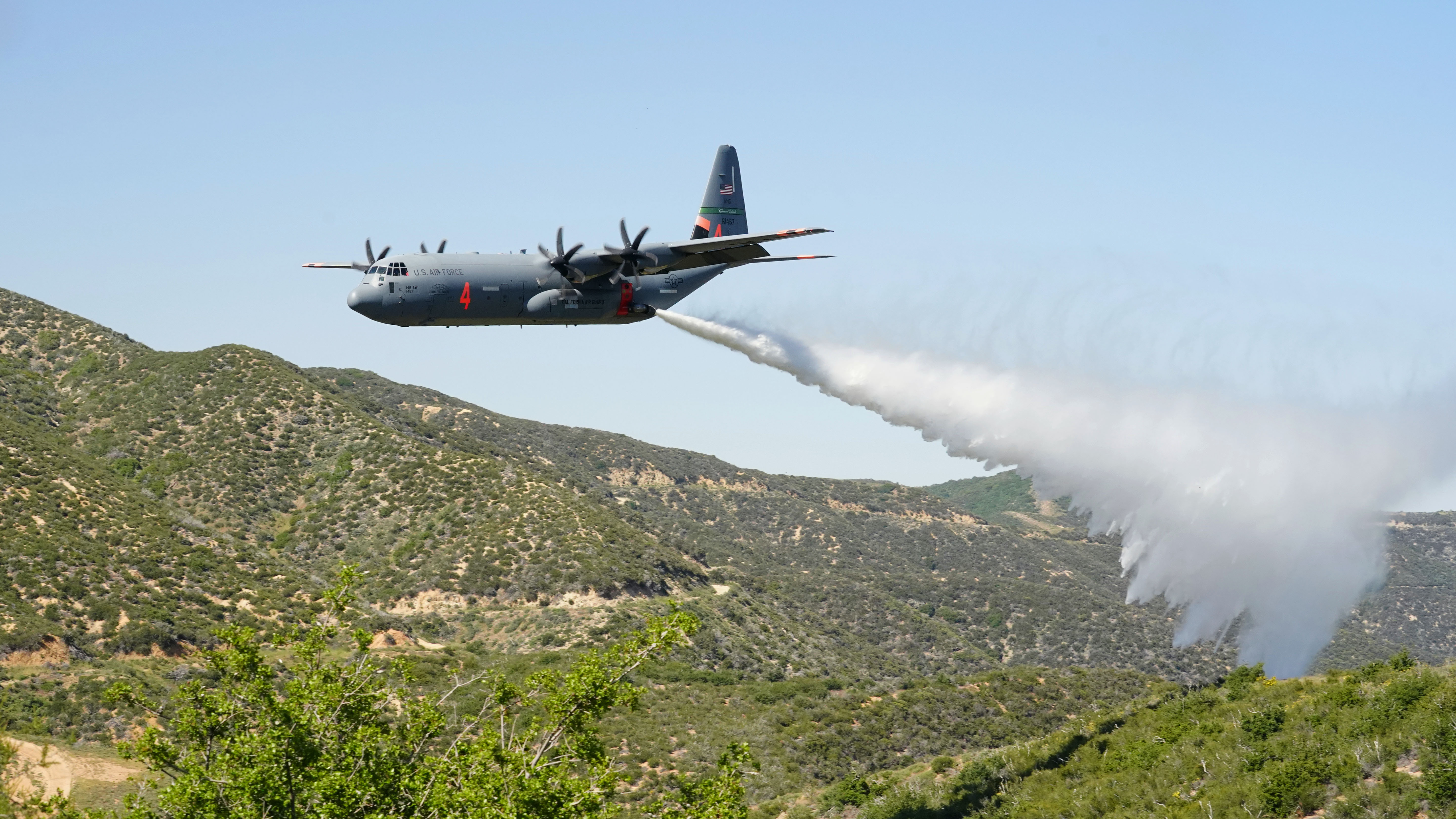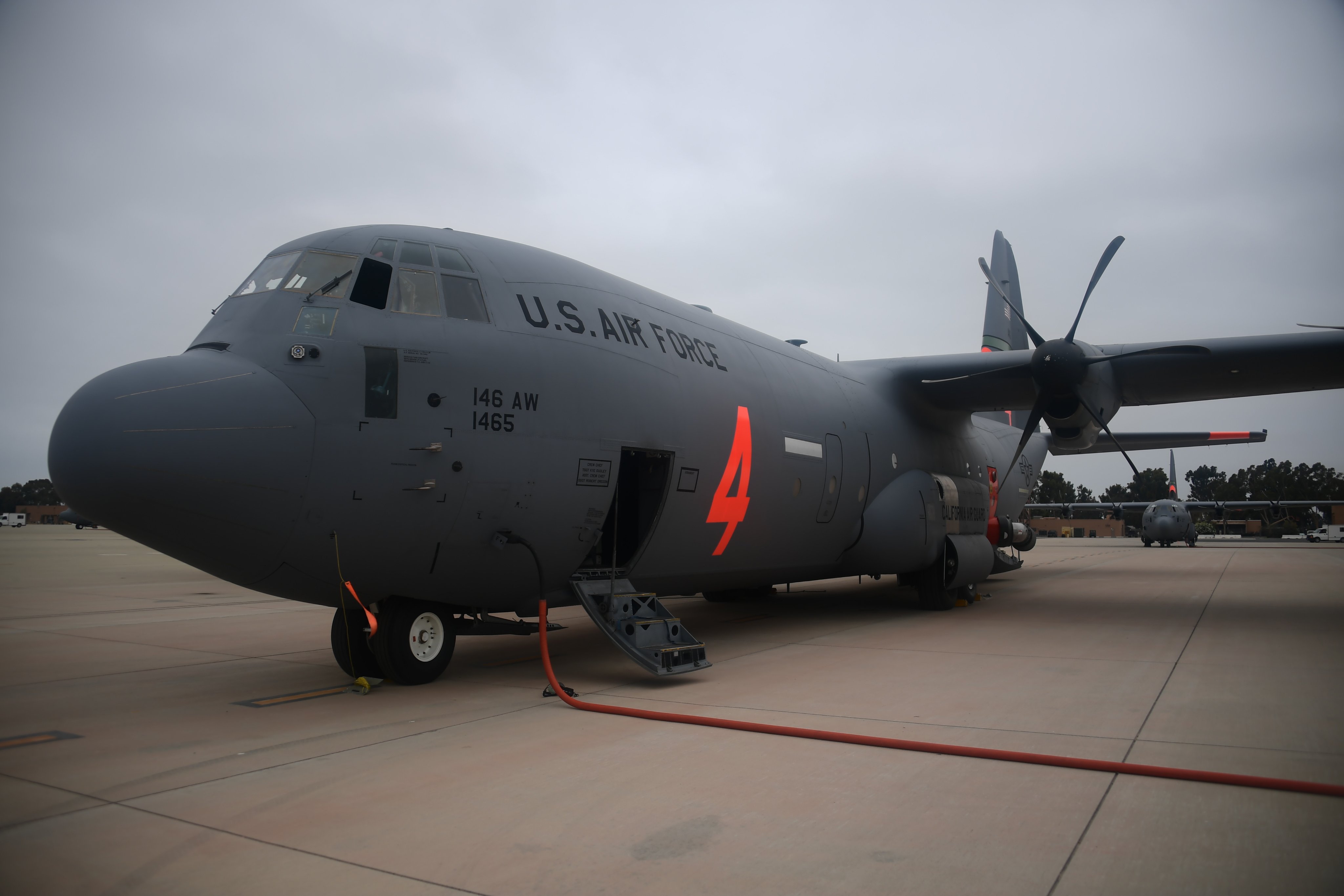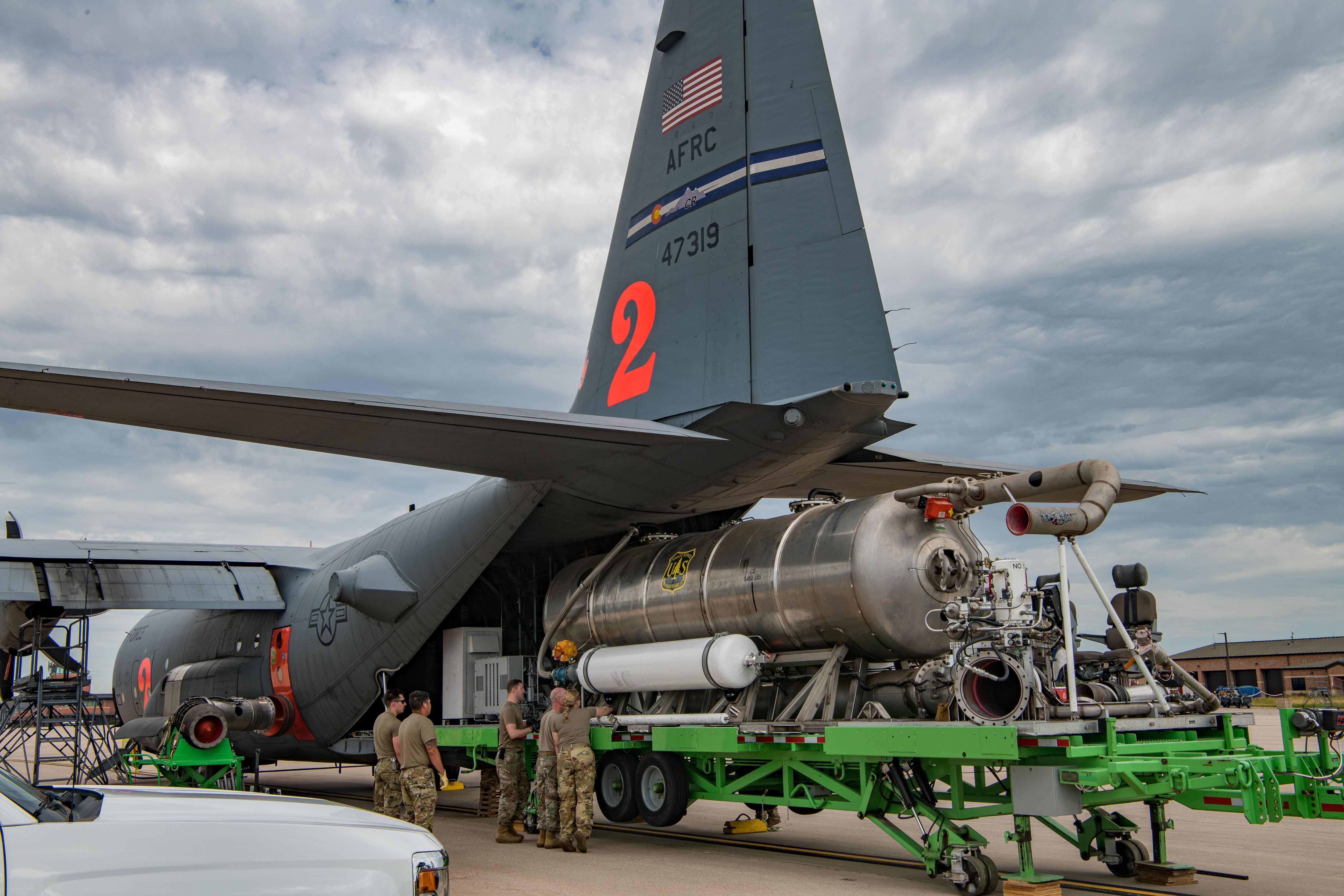Military Support in Wildfire Suppression (1988-present)
Since 1975, the US Department of Agriculture and Department of the Interior have had an interagency agreement with the Department of Defense (DOD) which allows DOD to provide firefighting support to the wildland fire management agencies when needed.
The US military is normally requested when national civilian resources are committed to fires and there is the need for further resources. The decision to request military support rests with the National Multi-Agency Coordinating (NMAC) Group at the National Interagency Fire Center (NIFC). As needed, the military will send a liaison officer to NIFC who coordinates closely with the National Interagency Coordination Center (NICC). NICC coordinates and tracks national firefighting requirements and plays a key role in the mobilization of military resources. The US military may provide aerial and/or ground resources.
The military also supports firefighting efforts through the Modular Airborne Firefighting System (MAFFS) program. This program provides Air National Guard and Air Force Reserve units flying in military C-130 aircraft equipped as airtankers to support wildland fire suppression activities. Aircrews get annual training and are certified by NIFC.
Military resources for ground firefighting are normally requested in battalion strength, which is equivalent to 25 20-person crews and their command-and-control elements. Each battalion fields about 550 personnel.
The military has provided firefighters and MAFFS support during several critical fire seasons, including 1988, 1989, 1990, 1994, 1996, 2000, 2001, 2002, 2003, 2006, 2015, 2018, 2020, 2021 and 2024. MAFFS only support occurred in 2004, 2005, 2007, 2008, 2011, 2012, 2013, 2014, 2016, 2022 and 2023.
2024
On August 6, the National Multi-Agency Coordinating Group (NMAC) requested a half battalion of active-duty military personnel to assist with fires on the Boise and Payette National Forests.
Over 250 active-duty personnel with the 14th Brigade Engineer Battalion at Joint Base Lewis-McChord were mobilized with firefighting protective gear from the National Interagency Fire Center, in Boise, Idaho on Saturday, August 17, 2024. They completed their assignments on Sunday, September 15.
Modular Airborne Fire Fighting Systems (MAFFS) C-130 airtankers and support personnel from the 153rd Airlift Wing (WY Air National Guard), 302nd Airlift Wing (CO Air Force Reserve), 146th Airlift Wing (CA Air National Guard), and 152nd Airlift Wing (NV Air National Guard) were deployed to Port Hueneme, California, to support wildland fire operations nationally.
2023
Two MAFFS C-130 airtankers and support personnel from the 153rd Airlift Wing (Wyoming Air National Guard) and the 302nd Airlift Wing (Colorado Air Force Reserve) were deployed to Klamath Falls, Oregon to support wildland fire operations nationally on August 9. These aircraft flew 287 sorties and dropped 610,173 gallons of retardant. They were released on September 6.
2022
Two MAFFS C-130 airtankers and support personnel from the 152nd Airlift Wing (Nevada Air National Guard) and one MAFFS C-130 airtanker and support personnel from the 146th Airlift Wing (California Air National Guard) were deployed to Boise, ID to support wildland fire operations nationally on September 9. Over the next eight days, these aircraft flew 8 sorties and dropped 16,700 gallons of retardant before being released on September 16.2021
In August 2021, NIFC requested 200 active duty military personnel along with command and support staff to assist with firefighting efforts. The DoD approved the request and identified the 23rd Brigade Engineer Battalion and the 2-3 Infantry Battalion, both at Joint Base Lewis-McChord (JBLM) near Tacoma, Washington to provide the active duty military personnel. They were assigned to the Dixie Fire.
2021
In August 2021, NIFC requested 200 active-duty military personnel along with command and support staff to assist with firefighting efforts. The DoD approved the request and identified the 23rd Brigade Engineer Battalion and the 2-3 Infantry Battalion, both at Joint Base Lewis-McChord (JBLM) near Tacoma, Washington to provide the active-duty military personnel. They were assigned to the Dixie Fire.
Two MAFFS C-130 airtankers and support personnel each from the 152nd Airlift Wing (Nevada Air National Guard), one MAFFS unit from the 302nd Airlift Wing (Colorado Air Force Reserve), one MAFFS unit from the 153rd Airlift Wing (Wyoming Air National Guard) and one from the 146th Airlift Wing (California Air National Guard) were deployed to McClellan, California to support wildland fire operations nationally. Before being released on September 29, these aircraft flow 945 sorties and dropped 2,583,204 gallons of retardant.
Two RC-26 aircraft with DRTI capability and support personnel were activated on July 8. One from the 141st Air Refueling Wing (Washington Air National Guard) was deployed to Fairchild, Washington. One from the 162nd Operations Group (Arizona Air National Guard) was deployed to Eugene, Oregon. While assigned these aircraft flew 143 sorties and mapped 268 wildfires. They were released on October 15.
2020
In 2020, the NICC processed two military battalion requests, provided by the US Army (Joint Base Lewis-McChord) and Marine Corps (Base Camp Pendleton) and mobilized other members of the Department of Defense to support wildfires in California.
On July 23, two military C-130s equipped with MAFFS, one from the 152nd Airlift Wing (Nevada Air National Guard) and one from the 302nd Airlift Wing (Colorado Air Force Reserve) were mobilized to McClellan Airfield, California, in support of wildland fire operations.
One RC-26 aircraft with Distributed Real-Time Infrared (DRTI) capability and support personnel from the 141st Air Refueling Wing (Washington Air National Guard) has been deployed to Fairchild AFB (Spokane, WA), in support of wildland fire operations. These aircraft flew 519 sorties and dropped 1,350,298 gallons of retardant before being released on October 4.
2018
In August 2018, NIFC requested 200 active-duty military personnel along with command and support staff to assist with firefighting efforts. The DoD approved the request and identified the 14th Brigade Engineer Battalion at Joint Base Lewis-McChord (JBLM) near Tacoma, Washington to provide the active-duty military personnel. They were assigned to the Mendocino Complex.
Four military C-130s equipped with Modular Airborne Fire Fighting Systems (MAFFS) were also mobilized to serve as large airtankers and operated from the Sacramento McClellan Airport in California. These aircraft dropped more than 644,000 gallons of retardant.
One military RC-26 aircraft was also mobilized to augment USDA Forest Service aircraft capability to detect and map wildfires in the western states and operated from Spokane, Washington.
2016
On August 4, two MAFFS units were activated through a Request for Assistance (RFA) to the Department of Defense (DOD). This request was filled with one MAFFS from the 153rd Airlift Wing and one MAFFS from the 302nd Airlift Wing were positioned at Boise, Idaho, in support wildland fire operations. On August 19 one additional MAFFS from the 153rd Airlift Wing was positioned at Boise, Idaho. On August 17 one MAFFS from the 153rd Airlift Wing was released back to the DOD. On September 4 the remaining two MAFFS each from the 302nd and 153rd Airlift Wing were released back to the DOD. MAFFS units primarily provided retardant delivery primarily to the Great Basin and Northwest Geographic Areas while employed from August 4 through September 12. These units delivered a total of 395,632 gallons of retardant while conducting 165 sorties.
2015
On August 4, four MAFFS units were activated through a Request for Assistance (RFA) to the Department of Defense. This request was filled with two MAFFS from the 146th Airlift Wing and two MAFFS from the 302nd Airlift Wing were positioned at McClellan, CA in support wildland fire operations. The two MAFFS from the 146th Airlift Wing were released back to the DOD on August 9.
On August 15, one MAFFS unit from each of the 153rd Airlift Wing and the 145th Airlift Wing were also positioned to McClellan, California. On August 23 two additional MAFFS from the 302nd Airlift Wing were mobilized to Channel Islands, California. The two MAFFS from the 302nd Airlift Wing were released back to the DOD September 3. The single MAFFS units from the 153rd Airlift Wing and the 145th Airlift Wing were re-positioned to Channel Islands California. All MAFFS units were released back to the DOD on September 12. MAFFS units primarily provided retardant delivery to the Northern California and Southern California Geographic Areas while employed from August 3 through September 12. These units delivered a total of 842,983 gallons of retardant while conducting 372 sorties. This is up from 2014 when 88 sorties were flown delivering 246,854 gallons of retardant.
Beginning August 18, two-hundred soldiers from the 17th Field Artillery Brigade based out of Fort Lewis Washington were trained as firefighters, and then assigned to wildfires within Washington State for thirty days.
2014
On July 20, Two MAFFS units were activated through a Request for Assistance (RFA) to the Department of Defense and MAFFS 1 and MAFFS 3 were positioned at Boise, Idaho to support fire suppression efforts in the western US. On August 17, MAFFS 3 experienced a hard landing at Hill AFB. While no injuries occurred, the damage ended the service of MAFFS 3 for 2014, but MAFFS1 stayed in service until August 24. MAFFS units provided retardant delivery to the Great Basin, Northwest and Northern Rocky Geographic Areas while employed from July 20 through August 24, delivering a total of 246,854 gallons while conducting 88 sorties. This is down from 2013 when 576 sorties were flown delivering 1,387,881 gallons of retardant.
2013
On June 11, a Request for Assistance for four military C-130 MAFFS aircraft was approved, and the first MAFFS began flying fire missions in Colorado on June 12. All available MAFFS aircraft (from California, North Carolina, Wyoming and Colorado) were activated at various times during the fire season. The MAFFS were released on July 13 but reactivated on July 20. On September 7, the remaining two MAFFS were released and returned to their home stations. In 2013 MAFFS flew 576 wildland fire sorties across the western U.S. and dropped 1,387,881 gallons of retardant.
2012
On June 23, a Request for Assistance for four military C-130 MAFFS aircraft was approved, and the first MAFFS began flying fire missions in Colorado on June 25. All available MAFFS aircraft (from California, North Carolina, Wyoming and Colorado) were activated at various times during the fire season. By September 13, MAFFS had flown 922 sorties across the western U.S., dropping 2,449,679 gallons of retardant. This is the highest number of gallons dropped by MAFFS since 1994. The last two MAFFS aircraft were released September 14 from Sacramento, CA.
2011
Four military C-130 Modular Airborne Firefighting System (MAFFS) activations occurred in 2011 in support of wildland fire suppression in Mexico, Texas, the Southwest and other parts of the West. The first mobilization to Texas occurred on April 15 to suppress fires burning in Mexico. Two MAFFS flew 37 sorties into Mexico from April 16 to April 23, and dropped 105,000 gallons of retardant.
The second activation involved MAFFS from California, North Carolina, Colorado and Wyoming. These aircraft flew 101 sorties from April 17 to May 4 in Texas, and dropped a total of 315,000 gallons of retardant.
The third MAFFS activation occurred from June 15 to July 13 and involved six MAFFS from California, North Carolina and Colorado at different times during this period. These aircraft were based in Albuquerque, New Mexico, and flew a total of 287 sorties and dropped 610,173 gallons of retardant in Arizona and New Mexico.
The fourth MAFFS activation occurred on September 8 and involved six MAFFS from Colorado, Wyoming and North Carolina (two from each state). The Wyoming MAFFS were based in Boise, Idaho, and flew 13 sorties, dropping 5,439 gallons of retardant in Idaho and Oregon. The other four MAFFS were based in Austin, Texas, and flew 92 sorties, dropping 154,250 gallons of retardant in Texas. The Wyoming MAFFS were released on September 18.
The North Carolina MAFFS were released on September 22, and the Colorado MAFFS were released on September 30.
2008
Eight National Guard Modular Airborne Fire Fighting System (MAFFS) C-130 aircraft were deployed to California (the first on June 23) to support fire suppression operations in that state. These aircraft, three each from North Carolina and Wyoming, and two from Colorado flew 480 missions and dropped 1,325,000 gallons of fire retardant. The last MAFFS were released on August 1.
2007
Six Modular Airborne Fire Fighting System (MAFFS) C-130 aircraft were deployed to southern California in late October to support fire suppression operations. These aircraft, two each from North Carolina, Colorado and Wyoming National Guard units, were assigned from October 23 to November 6. The aircraft flew 98 missions and dropped 199,860 gallons of fire retardant.
2006
Two North Carolina Air National Guard Modular Airborne Fire Fighting Systems (MAFFS) were deployed on March 17 to Albuquerque, New Mexico. These aircraft were released March 27 without flying a fire mission. The two North Carolina Air National Guard MAFFS were redeployed to Mesa, Arizona from June 26 to July 7. The aircraft flew 44 sorties, delivering 109,423 gallons of retardant. Two Wyoming and Colorado Air National Guard MAFFS were deployed to Klamath Falls, Oregon from July 21 to September 13. The aircraft flew 318 sorties, delivering 699,941 gallons of retardant. Three California Air National Guard MAFFS were deployed to Boise, Idaho from August 5 to September 16 (the third MAFFS was only temporarily deployed). The aircraft flew 295 sorties, delivering 650,625 gallons of retardant.
In addition, a U.S. Army battalion (Fort Lewis, Washington) Task Force Blaze, was deployed to the Tripod Complex in the Northwest Area from August 13 to September 3.
2005
Four military C-130 aircraft equipped with the Modular Airborne Fire Fighting System (MAFFS) were activated on May 21. Operating out of the Boise Airtanker Base, the four aircraft flew 366 sorties for 510 flight hours and delivered 879,034 gallons of retardant on 47 fires in Idaho, Utah, Nevada, Washington and Oregon. The last missions were flown on September 5.
2004
Two Air Force Reserve MAFFS aircraft (from Peterson Air Force Base, Colorado Springs) supported fire suppression operations from May 14 to September 9 from bases in Arizona, New Mexico, Utah, Idaho, Washington and Oregon. These aircraft flew 327 sorties (about 347 hours of flight time) and delivered approximately 869,929 gallons of retardant to fires in the West.
2003
Task Force Steel Dragon (US Army 2nd Battalion, 82nd Field Artillery Regiment) from Fort Hood, TX were deployed to the Northern Rockies Area assisting fire suppression efforts in western Montana from August 24th through September 13.
2002
Military battalion from Fort Riley, Kansas assisted with fires in Oregon from July 23 through August 16. They were first assigned to the Monument Fire near Unity, OR and then moved to the Tiller Complex near Tiller.
MAFFS were deployed to Colorado Springs, CO; San Bernardino, CA; Hill Air Force Base, UT; Boise, ID; and Spokane, WA.
2001
Two military battalions from Fort Lewis were assigned from August 24 to September 3 to the Virginia Lake Complex in Washington.
MAFFS were deployed to Washington and Oregon.
2000
Five military battalions were deployed in 2000. Task Force Thunder from Fort Hood supported efforts on the Burgdorf Junction Fire near McCall, ID. Task Force Wildfire from Camp Pendleton assisted on the Clear Creek Fire near Salmon, ID. Task Force Lumberjack from Fort Hood worked on the Upper Nine Mile Complex near Huson, MT. Task Force Four from Fort Campbell fought fires on the Bitterroot National Forest. The fifth Task Force from Fort Bragg was assigned to the Troy South Fire on the Kootenai National Forest.
1996
An Army battalion from Fort Carson and a Marine battalion from Camp Pendleton assisted with firefighting efforts.
MAFFS were deployed to northern California.
1994
Seven military battalions were activated during 1994, including two Marine battalions from Camp Pendleton and five Army battalions (two from Fort Hood, two from Fort Lewis, and one from Fort Riley).
MAFFS were deployed to Idaho, Washington, and Montana.
1990
Four Army battalions (two from Fort Lewis and two from Fort Carson) assisted firefighting efforts in Oregon and California.
MAFFS were deployed to southern California.
1989
Four Army battalions (two from Fort Lewis, one from Fort Carson, and one from Fort Riley) assisted on fires in Idaho and Oregon.
MAFFS and 19 helicopters from Fort Campbell were also deployed to Idaho and Oregon.
1988
Six Army and two Marine battalions provided firefighting assistance during the Yellowstone Fires.
MAFFS and 57 helicopters were also deployed to Yellowstone.












